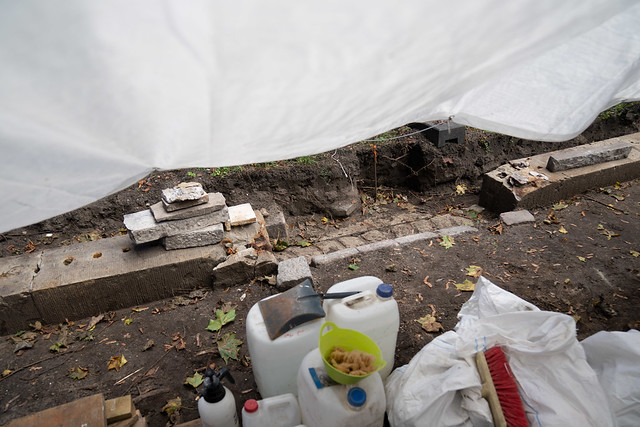Restoration and reconstruction of the monuments of the Vērmaņi family in the Great Cemetery has begun on behalf of the Riga Municipal Monument Agency. The work is being carried out by SIA „Koka ēka” in accordance with the conditions of the public tender and the restoration rules
"The revival of the historic cemetery site of the Riga's patrons Vērmaņi family in the Great Cemetery serves three purposes. Firstly, we are repaying a debt to the people who have loved our city and given it lasting treasures, including the beloved Vērmane Garden. Secondly, we will have an authentically restored unique object - the early 19th century Riga's patrician burial site in all its glory. And finally, we will celebrate the 250th anniversary of the Great Cemetery with another beautifully restored jewel," says Rita Našeniece, Head of the Riga City Council's Tangible Cultural Heritage Commission.
"The initial stage of the restoration and reconstruction of the two monuments of the Vērmaņi family involved cleaning the surfaces of the monuments of household dirt and biological plant cover - moss, lichen and algae. Further, it is planned to prevent the foundations of the monuments from tilting and to ensure their stability. By exposing the bases of the monuments, it was found out that the foundations of the original perimeter fencing have been preserved. In parallel, architectural and compositional solutions are being sought so that the monuments can be displayed in harmony with the surrounding landscape and adapted to the everyday needs of the city residents," elaborates Guna Vainovska, the Chief Specialist of the Riga Municipal Monument Agency.
By the end of the restoration season at the end of October, the two monuments will be conserved and prepared for the continuing restoration and reconstruction phases planned for next year. During the winter, work will continue in the restoration workshops, where the most important lost elements of the historic monuments will be reconstructed. The restoration of the lost elements of the monuments of the Vērmaņi family from the wall of the portals of the Row Chapels and the reconstruction of the lost elements are also planned. The work is carried out in accordance with the scientific restoration methodology and are approved by The State Inspection for Heritage Protection.
About the Vērmaņi family
The name of the patrons the Vērmaņi family is closely linked to the history of Riga. Christian Heinrich Wehrmann, a merchant from Lübeck, moved to Riga in 1763, where he worked as a sales partner for Krupp & Wöhrmann and Wöhrmann & Detenhoff. K.H.Vērmanis was a senior member of the Riga Blackheads' Society and a member of the Riga Great Guild. In 1772 the merchant married Anna Ģertrūde Ēbele. After the fire of 1812, when the Central District (a former suburb of St. Petersburg) suffered the most, it was necessary to improve the quality of life of the city residents. The newly appointed Governor General of Riga, Marquis Philip Paulucci, proposed the creation of public green spaces on the territory of the fortress esplanade. The city did not have the funds for this project, so the Governor General appealed to the residents to donate.
One of the first to respond to the appeal was A.Ģ.Vērmane, who donated 10000 roubles for the planting of exotic trees and shrubs. The newly created City Greenery Committee allocated a swampy plot of land behind the city ramparts for the park - the esplanade. The 0.8 ha of greenery was created and opened to the public on 8 June 1817. A.Ģ.Vērmane also presented the city with securities worth of 2000 silver roubles and the interest from which was to cover the maintenance and improvement of the park. The patron's son, Johans Kristofs Vērmanis, who was also one of the founders of the Riga Stock Exchange Committee in 1816, continued his mother's work in improving and expanding the garden. Also A.Ģ.Vērmane's grandson Kristiāns Heinrihs Vērmanis was the Consul General of Prussia in the 1860s, he continued the traditions started by his family and on his initiative the creation of Arcadia Park in Pārdaugava was started. After the 1920 land reform, the Vērmaņi lost most of their property and left Latvia and Estonia by the end of 1939.
About the Great Cemetery
The protected architectural monument of national importance, the "Great Cemetery" ensemble of gardens and parks with memorial buildings covers 36.7 hectares. It includes the Pokrov or Orthodox section, the Lutheran section of Jēkabs Church and the part of the so-called Great Cemetery, which included other parish cemeteries of the Lutheran churches of the City. Today, the municipality manages 27.8 hectares of the whole historic site. The cemetery has more than 400 monuments dedicated to different families or individuals in Riga. For example, the Young Latvians - Krišjānis Barons, Krišjānis Valdemārs, Andrejs Pumpurs and Fricis Brīvzemnieks. The Great Cemetery also houses memorials to former Riga Mayor George Armitstead and art historian Vilhelms Neimanis, among other residents. Several graves have been preserved in their original state. For example, the Erhard family, one of whose members served as Riga's Mayor until the Bolsheviks entered the city in 1919. Also to the painter Voldemārs Zeltiņš, the sculptor Augusts Folcs and other cultural and public figures.
Author: Kaspars Līcītis – Project Coordinator at External Communication Division of Riga City Council Communication Department, e-mail: kaspars.licitis@riga.lv., in cooperation with RPA "Riga Municipal Monument Agency".




